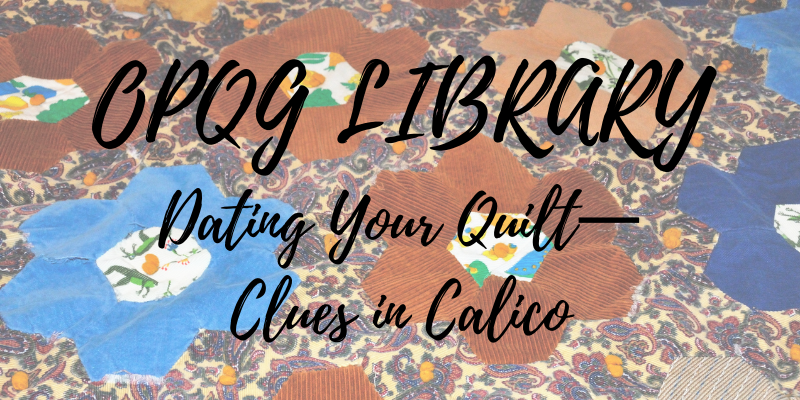How to Become a Quilt Detective by OPQG Librarian, Loretta Hermann
Perhaps you have inherited some old quilts, or you got carried away at an auction and purchased some old quilts. Most vintage quilts do not have a label on them. “Curiosity killed the kitty-cat,” so the saying goes. To satisfy your curiosity as to how old your quilt might be, you will need some help. If you inherited a quilt and know who made it and approximately when the family member was involved in quilting, make a label with that information, and attach it to the quilt. Some old quilts, such as friendship or commemorative quilts, have names and dates embroidered on the blocks. If you purchased a quilt and this information was not obvious, you need to become a detective, just like Nancy Drew, and look for clues.
 The OPQG Library has Clues in the Calico by Barbara Brackman as a guide to identifying and dating antique quilts. The book views quilts from different aspects from three major perspectives: names, categories and clues. Compare the names of colors and techniques through various periods. Categories of quilts come in and out of fashion. For example, whole cloth wool quilts fell out of favor before the Civil War. Using a computer file of nearly 900 American quilts that had dates on them, patterns of popularity were quickly discernable to be used as a comparison. The author instructs the reader on how to look for clues in the fabric, style, color, technique and pattern to date a quilt.
The OPQG Library has Clues in the Calico by Barbara Brackman as a guide to identifying and dating antique quilts. The book views quilts from different aspects from three major perspectives: names, categories and clues. Compare the names of colors and techniques through various periods. Categories of quilts come in and out of fashion. For example, whole cloth wool quilts fell out of favor before the Civil War. Using a computer file of nearly 900 American quilts that had dates on them, patterns of popularity were quickly discernable to be used as a comparison. The author instructs the reader on how to look for clues in the fabric, style, color, technique and pattern to date a quilt.
The book is divided into the following eras: Before 1800, 1800-1840, 1840-1865, 1865-1900, 1900-1925, 1925-1950. Each era includes pictures of quilts and patterns to help identify a quilt of that era. A chapter on determining the fabric content gives clues to the age of the material used. Other clues must be used to date a quilt other than fabric because quilters sometimes use fabric they purchased and stored, waiting for the right time to make it into a quilt.
Another clue is the type of filler or batting used. Batting has changed significantly over the decades. Before the introduction of polyester in 1960, cotton or wool was the most common option. The most significant change in the coloring of fabrics was the development of synthetic dyes. This clue affects how the fabric fades as it ages. The print’s size and color on the fabric are determined by how the print was applied to the material. Early quilts were printed by applying dye in a free-hand style. The most common method to print a pattern is to use a repetitive technique. This technique could be a roller, a machine, or a plate. Whether abstract, floral, or object, the type of print provides vital clues to the era. The different styles of sewing, including applique, borders, cording, piecing, setting, and backing, provide additional clues.
Using the clues throughout the book, the quilt detective can complete a copy of the worksheet at the back of the book to determine an approximate date that their mystery quilt was made. EUREKA! The mystery is solved!
The OPQG Library has many books on different topics related to quilting. Stop by the guild whenever it is open for meetings and browse. If you are looking for a book on a particular subject, look through the catalog file or ask the librarian for assistance.

